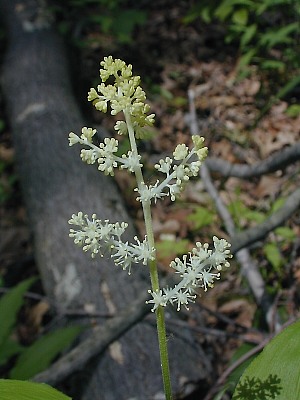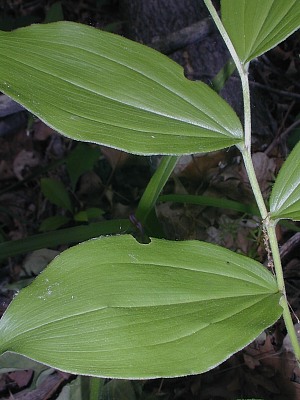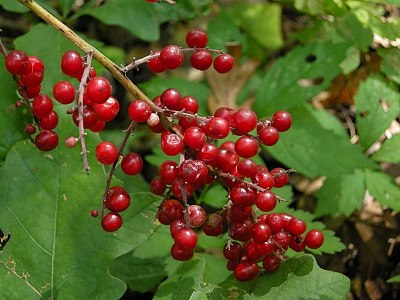Description: This herbaceous perennial plant is unbranched and up to 2½' tall. The central stem is ascending, rather than stiffly erect. It is green to light green, slightly hairy, and sometimes zigzags between the alternate leaves. These leaves are up to 6" long and 3" across. They are broadly ovate, smooth along the margins, and usually glabrous on the upper surface. Their venation is parallel, while at the base they are mostly sessile against the stem. The central stem terminates in a rather flat panicle of 20-80 white flowers. This panicle is about 4" long and 2" across; its whitish green stalks are softly hairy. Each flower is about 1/6" across, consisting of 6 tepals, 6 stamens, and a central pistil with a short stout style. These floral parts are white, except for the anthers of the stamens, which are cream or pale yellow. The filaments of the stamens are narrowly triangular, while the tepals are oblong-linear.

The blooming period occurs from late spring to early summer
and lasts
about 3 weeks. Each flower is replaced by a few-seeded berry.
Individual berries are about ¼" across and globular; they become bright
red, or red and purple-striped at maturity. The root system consists of
stout rhizomes with secondary fibrous roots. This plant sometimes forms
loose vegetative colonies.
Cultivation:
The preference is light shade to partial sun, moist to slightly dry
conditions, and a fertile loamy soil with abundant organic material
(i.e., decaying leaves). Sandy and rocky soil are also tolerated.
Range & Habitat:
False Solomon's Seal is a common plant that occurs in every county of
Illinois (see Distribution
Map), where it is native. Habitats include mesic to dry
deciduous woodlands,
rocky wooded slopes, bluffs, and Black Oak foredunes near Lake Michigan.

Faunal
Associations:
The flowers are pollinated by small bees, flies, and beetles. The bees
collect pollen from the flowers, while flies and beetles feed on
pollen. The flowers appear to attract more than the usual number of
beetles, including Seed Beetles, Long-Horned Beetles, Click Beetles,
Blister Beetles, Tumbling Flower Beetles, Flower Scarab Beetles
(Trichiotinus spp.), and Pedilid Beetles (Pedilus spp.). The berries
are eaten occasionally by woodland birds, including the Ruffed Grouse
and Veery; they are also eaten by the White-Footed Mouse. These animals
spread the seeds into new areas. The foliage is browsed occasionally by
the White-Tailed Deer.
Photographic Location:
Along the slope of a wooded bluff in Vermilion County, Illinois.

Comments: This interesting plant produces attractive flowers and berries. It has a similar appearance to Smilacina stellata (Starry False Solomon's Seal), but the latter species produces a raceme of flowers, rather than a branching panicle. The flowers of Starry False Solomon's Seal are somewhat larger in size and fewer in number (less than 20 per raceme), and its leaves are more narrow. Another species, Polygonatum commutatum (Solomon's Seal), has very similar foliage, but its leaves slightly clasp the central stem. The flowers of Solomon's Seal have a very different appearance; their corolla is tubular-shaped and greenish white. Furthermore, the flowers of Solomon's Seal hang from the central stem in small umbels of 1-5 flowers; these umbels develop from the base of each leaf. The scientific name of Smilacina racemosa is something of a misnomer as this species produces flowers in panicles, rather than racemes. Another common name for this species is Solomon's Plume, although it appears to be passing out of fashion.